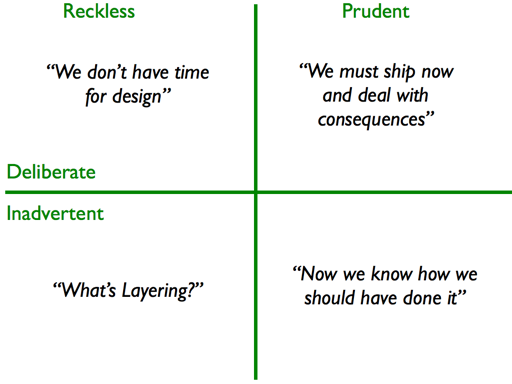Technical Debt Quadrant
14 October 2009
There's been a few posts over the last couple of months about TechnicalDebt that's raised the question of what kinds of design flaws should or shouldn't be classified as Technical Debt.
A good example of this is Uncle Bob's post saying a mess is not a debt. His argument is that messy code, produced by people who are ignorant of good design practices, shouldn't be a debt. Technical Debt should be reserved for cases when people have made a considered decision to adopt a design strategy that isn't sustainable in the longer term, but yields a short term benefit, such as making a release. The point is that the debt yields value sooner, but needs to be paid off as soon as possible.
To my mind, the question of whether a design flaw is or isn't debt is the wrong question. Technical Debt is a metaphor, so the real question is whether or not the debt metaphor is helpful about thinking about how to deal with design problems, and how to communicate that thinking. A particular benefit of the debt metaphor is that it's very handy for communicating to non-technical people.
I think that the debt metaphor works well in both cases - the difference is in nature of the debt. A mess is a reckless debt which results in crippling interest payments or a long period of paying down the principal. We have a few projects where we've taken over a code base with a high debt and found the metaphor very useful in discussing with client management how to deal with it.
The debt metaphor reminds us about the choices we can make with design flaws. The prudent debt to reach a release may not be worth paying down if the interest payments are sufficiently small - such as if it were in a rarely touched part of the code-base.
So the useful distinction isn't between debt or non-debt, but between prudent and reckless debt.
There's another interesting distinction in the example I just outlined. Not just is there a difference between prudent and reckless debt, there's also a difference between deliberate and inadvertent debt. The prudent debt example is deliberate because the team knows they are taking on a debt, and thus puts some thought as to whether the payoff for an earlier release is greater than the costs of paying it off. A team ignorant of design practices is taking on its reckless debt without even realizing how much hock it's getting into.
Reckless debt may not be inadvertent. A team may know about good design practices, even be capable of practicing them, but decide to go “quick and dirty” because they think they can't afford the time required to write clean code. I agree with Uncle Bob that this is usually a reckless debt, because people underestimate where the DesignPayoffLine is. The whole point of good design and clean code is to make you go faster - if it didn't people like Uncle Bob, Kent Beck, and Ward Cunningham wouldn't be spending time talking about it.
Dividing debt into reckless/prudent and deliberate/inadvertent implies a quadrant, and I've only discussed three cells. So is there such a thing as prudent-inadvertent debt? Although such a thing sounds odd, I believe that it is - and it's not just common but inevitable for teams that are excellent designers.
I was chatting with a colleague recently about a project he'd just rolled off from. The project that delivered valuable software, the client was happy, and the code was clean. But he wasn't happy with the code. He felt the team had done a good job, but now they realize what the design ought to have been.
I hear this all the time from the best developers. The point is that while you're programming, you are learning. It's often the case that it can take a year of programming on a project before you understand what the best design approach should have been. Perhaps one should plan projects to spend a year building a system that you throw away and rebuild, as Fred Brooks suggested, but that's a tricky plan to sell. Instead what you find is that the moment you realize what the design should have been, you also realize that you have an inadvertent debt. This is the kind of debt that Ward talked about in his video.
The decision of paying the interest versus paying down the principal still applies, so the metaphor is still helpful for this case. However a problem with using the debt metaphor for this is that I can't conceive of a parallel with taking on a prudent-inadvertent financial debt. As a result I would think it would be difficult to explain to managers why this debt appeared. My view is this kind of debt is inevitable and thus should be expected. Even the best teams will have debt to deal with as a project goes on - even more reason not to recklessly overload it with crummy code.

reposted on 19 Nov 2014

